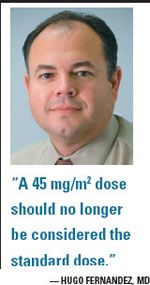Younger acute myelogenous leukemia patients respond favorably to anthracycline dose intensification
Induction therapy with higher daily doses of daunorubicin improved complete response and boosted overall survival in younger patients with acute myelogenous leukemia, according to results of the phase III ECOG E1900 trial.
Induction therapy with higher daily doses of daunorubicin improved complete response and boosted overall survival in younger patients with acute myelogenous leukemia, according to results of the phase III ECOG E1900 trial. Although the risk of cardiotoxicity with a higher dose remains unknown, the low-dose regimen can no longer be considered the standard of care, said the trial's principal investigator.
Using daunorubicin 90 mg/m2 achieved a complete response (CR) of 70.6% vs 57.3% for a lower dose of 45 mg/m2, and improved median overall survival (OS) by eight months. The higher dose did not increase toxicity over the short term and a similar percentage of patients in each arm could go on to consolidation therapy prior to stem cell transplant.
The comparison of the two doses of daunorubicin as induction therapy was built in to a trial originally designed to evaluate gemtuzumab (Mylotarg) as part of consolidation therapy prior to stem cell transplant, explained lead author Hugo Fernandez, MD, associate member at H. Lee Moffitt Cancer Center in Tampa, Fla. Prior phase I evidence suggested that the 90 mg/m2 dose of daunorubicin could improve CR rates over those achieved with the standard 45 mg/m2 dose (ASCO 2009 abstract 7003).

E1900 update
Dr. Fernandez presented follow-up data at ASH 2009, focusing on de novo autologous hematopoietic cell transplantation as consolidation for younger patients in first complete remission. The patients were initially randomized to standard-dose cytarabine and either standard- or high-dose daunorubicin.
The median follow-up was 31.8 months. In the intention-to-treat analysis, median DFS was 21.1 months and OS was 31.8 months. For patients treated per protocol, median DFS was 29.8 months and median OS was 39.7 months (abstract 3405).
The authors reported that patients who were FLT3-positive demonstrated a trend toward worse outcomes compared with patients who were FLT3-negative: 16.2 vs 30.3 months for DFS (P = .12) and 20 vs 39.7 months for OS (P = .10).
"Despite the improved survival in this study, I'm not sure that all oncologists will be comfortable with the 90 mg/m2 dose because of a potential, yet unknown, risk of late cardiotoxicity. [But] the most important issue in acute leukemia is to gain early control of the disease; otherwise patients die. This study suggests that the higher dose is better, and should move oncologists toward using doses higher than 45 mg/m2," Dr. Fernandez said.
He noted that other groups have incorporated daunorubicin 60 mg/m2 as induction therapy and said that oncologists may be more comfortable with that dose. He pointed out, however, that there is no evidence from a randomized trial to compare the 60 mg/m2 and 90 mg/m2 doses of daunorubicin.
The study enrolled 657 patients aged 60 and younger (median age 48). Both arms had similar demographic and disease characteristics. After induction therapy, patients with CR went on to consolidation therapy and stem cell transplant. The study was closed early due to the improved OS.
Among 547 patients evaluable for response, CR and OS were improved by the higher dose daunorubicin. Overall survival was 23.7 months in the high-dose arm 15.7 months in the standard-dose arm. Dr. Fernandez said that "a 45 mg/m2 should no longer be considered the standard dose."
Toxicity was similar in the two arms. Induction deaths were 4.5% and 5.5% for the 45 mg/m2 and 90 mg/m2 arms, respectively. Grade 3 and 4 toxicity was similar in both arms, with no evidence of increased cardiac toxicity in the high-dose arm. About 50% of patients in both arms went on to consolidation therapy.
Patients with favorable and intermediate cytogenetics had improved CR and OS on high-dose daunorubicin, and patients who were FLT3-negative had improved survival in the high-dose arm (see Related Reading above).
Limitations of the E1900 trial include the exclusion of older patients and the lack of data on how to treat patients with unfavorable cytogenetics (monosomy 7, monosomy 5, and complex cytogenetics with three or more abnormalities).
The CALBG 10603 RATIFY trial (chemotherapy with or without midostaurin in induction and consolidation) will shed some light on the effect of an FLT3 inhibitor on patients who are FLT3-positive, Dr. Fernandez said.
Vantage Point
Higher dose possible with supportive care

The trial results could alter the standard of care, Dr. Schiffer said. "This is one study you can take home with you. I consider it potentially practice-changing, particularly since it is consistent with a similar trial done in the Netherlands," he said.
Dr. Schiffer is a professor of medicine and oncology and head of the multidisciplinary leukemia/lymphoma team at the Karmanos Cancer Institute at Wayne State University in Detroit.
"The study showed that higher doses of daunorubicin (> 45 mg/m2) can be used safely without an increase in mucositis or other side effects, now that we have better supportive care with antiemetics, antifungals, and treatment for mucositis," Dr. Schiffer said. "It is reasonable to use 60 to 90 mg/m2 as induction for acute myelogenous leukemia."
But he cautioned that the higher dose may not be sufficient for all patients: Based on the trial results, higher risk patients over age 55 and FLT3-mutated and MLL-mutated patients did not benefit from an increased dose of daunorubicin.